The New York Times /Sinosphere /By
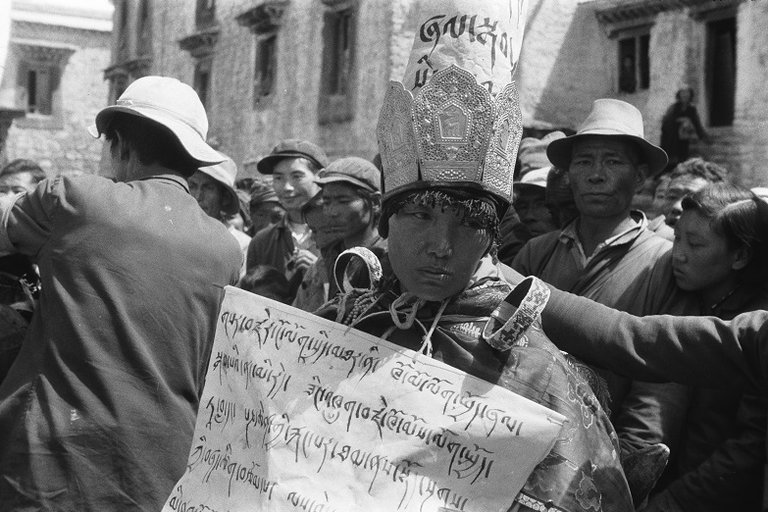
Tsering Woeser’s father, an officer in the People’s Liberation Army in Lhasa when the Cultural Revolution broke out in 1966, photographed many public attacks on Tibet’s old ruling class and religious leaders. Here, a Buddhist nun wears a sign labeling her as a counterrevolutionary. Credit Tsering Dorje
In 1999, the Tibetan writer Tsering Woeser came across Wang Lixiong’s book “Sky Burial: The Fate of Tibet.” On finishing it, she sent Mr. Wang photographs taken by her father, who was with the People’s Liberation Army when it entered Tibet in the 1950s and documented the early years of the Cultural Revolution in Lhasa in the 1960s. Mr. Wang wrote back, saying, “It’s not for me, as a non-Tibetan, to use these photos to reveal history. That task can only be yours.”
Ms. Woeser began tracking down and interviewing people who appeared in the photos. This resulted in two books published by Locus in Taiwan in 2006: “Forbidden Memory: Tibet During the Cultural Revolution,” based on her father’s photographs, and “Tibet Remembered,” an oral history narrated by 23 people who appear in them. Meanwhile, Ms. Woeser had begun taking her own photos, using her father’s camera, of the places he photographed. Many were included in a new edition of “Forbidden Memory,” published this year on the 50th anniversary of the start the Cultural Revolution.
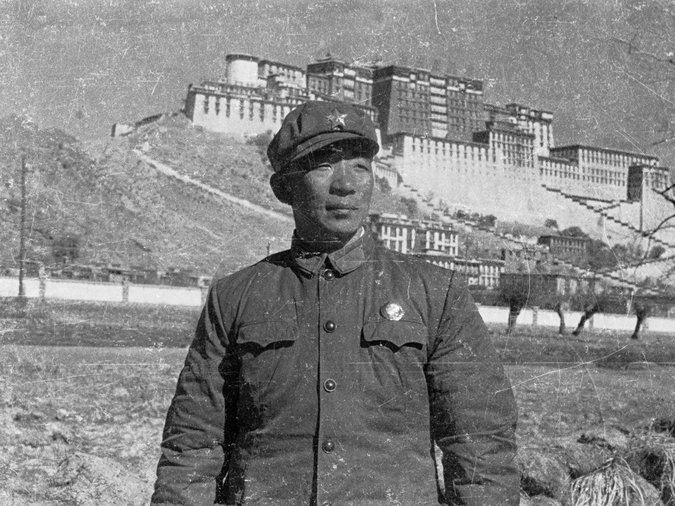
Tsering Dorje standing before the Potala Palace in Lhasa in 1969, in a photograph provided by his daughter, Tsering Woeser.
Ms. Woeser was born in Lhasa in 1966 to a Tibetan mother and her father, Tsering Dorje, who was half Tibetan and half Han, the dominant ethnicity in China. But in 1970, her father, who had served as deputy commander of the Lhasa military district, was transferred to Sichuan Province. It wasn’t until 1990 that Ms. Woeser returned to Lhasa, where she became editor of the journal “Tibetan Literature.” In 2003, she published “Notes on Tibet,” a collection of essays and short stories that was soon banned by the Chinese government. She is now a freelance writer and poet based in Beijing with Mr. Wang, whom she married in 2004. In an interview, she discussed what she learned from her father’s photographs of Tibet’s experience of the Cultural Revolution.
How did your father manage to take these photos?
In 1950, Mao Zedong ordered the People’s Liberation Army into Tibet, and on the way it passed through my father’s hometown, Derge, which is in the present-day Garze Tibetan Autonomous Prefecture in Sichuan. At the time my father, who was only 13, was sent away by his Han father to enlist in the P.L.A. His mother was a local Tibetan. During the Cultural Revolution, my father served as an officer in the political department of the Tibet Military District. I suppose he was able to take photos because of his privileges as a P.L.A. officer.
It’s curious, however, that for all the photos that my father took, he was able to keep the photos and negatives. This certainly could not have happened if the army had assigned him to take the photos. This indicates that my father’s activity was not commissioned by the military.
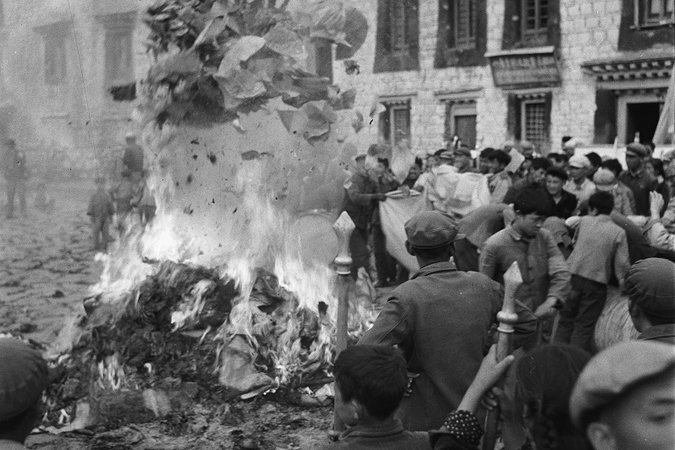
On Aug. 24, 1966, in Lhasa, Buddhist scriptures were burned as part of the campaign against the “Four Olds” — old customs, old culture, old habits, old ideas. Credit Tsering Dorje
Very few people had cameras then, and even fewer had the chance to take photos of public events. There were several media agencies active in Tibet then. They produced lots of documentaries, photos and reports. And yet in the newspapers and posters from then you can’t find any photos of ruined temples or “struggle sessions” against “counterrevolutionary monsters and demons.” I’ve looked at all the issues of Tibet Daily from 1966 to 1970 but can find no such photos.
What do your father’s photos show?
Mostly mass meetings and “incidents.” By mass meetings I mean large-scale gatherings such as the celebration by tens of thousands of Chairman Mao’s launching of the Cultural Revolution. Incidents include the destruction of temples and struggles against “monsters and demons.” The photos contain many identifiable figures including the Communist leaders of Tibet, the founder of the Tibetan Red Guards, individual Red Guards, as well as nobles, clergy and officials of the old Tibet society who were targeted in “struggle sessions.” In my investigations most of my efforts were focused on these people, because it’s through them that the photos have their greatest value. Over six years, I interviewed about 70 people in the photos.
How do your photographs and your father’s, taken in the same locations, differ?
In 1966 and 1967, my father took photos of mass meetings and rallies of Red Guards and the P.L.A. in front of the Potala Palace. In 2012, when I went to the same place to take photos, two self-immolations by Tibetans had taken place in Lhasa that May. As a result, the government tightened its policy of ethnic segregation and took more security measures against Tibetans, especially those from outside Lhasa. The measures were first implemented in March 2008, when protests broke out across the Tibetan region, and became more severe in 2012. As I took my photos, I noticed a curious phenomenon: the palace square was filled with men in black. They had umbrellas on their backs, which they would use to block people from taking pictures if an incident broke out. They lined up in rows and monitored the people passing by. They prohibited anyone from sitting in the square.
Another example: In 2014, I was standing where my father had taken photos in front of the Jokhang Temple. What did he see back then? Red Guards trying to hang Chairman Mao’s portrait on the roof of the temple, where the Chinese flag was also planted. Though I didn’t see any Mao portraits there, the flag was waving in the same place. Also, there were quite a few believers kneeling and praying, as well as a crowd of tourists fascinated by their actions. On the roof of a house diagonally across from the temple there were sharpshooters from the armed police. Ever since 2008, sharpshooters have been deployed on the roofs of buildings around the temple.
Comparing today with the Cultural Revolution, there were no believers kneeling back then, and the temple was ruined, while today the temple offers a bustling scene where believers may freely worship. But these are only superficial differences. Religious worship is still strictly controlled. Furthermore, there is now commercialized tourism, with gawking tourists who treat Tibetans like exotic decorations and Lhasa as a theme park.
Who was the founder of the Lhasa Red Guards?
Tao Changsong, born in Yangzhou, Jiangsu Province. In 1960, he graduated from East China Normal University and volunteered to move to Tibet, where he became a teacher of Chinese at Lhasa Middle School. During the Cultural Revolution he was the main force behind the creation of the Lhasa Red Guards, as well as commander of the Lhasa Revolutionary Rebels Headquarters. When the Revolutionary Committee of the Tibet Autonomous Region was formed, he became its deputy director, a position equivalent to vice chairman of the Tibet Autonomous Region today. He also went to Beijing many times and met with Zhou Enlai, Jiang Qing and other key members of the Central Revolutionary Committee. In 2001, I interviewed him twice. I didn’t show him my father’s photos, assuming he might not tell me the story if he saw them, since he appears in one. It shows him at the Dalai Lama’s summer palace, the Norbulingka, leading a team of Red Guards hanging up a poster on which is written “People’s Park.”
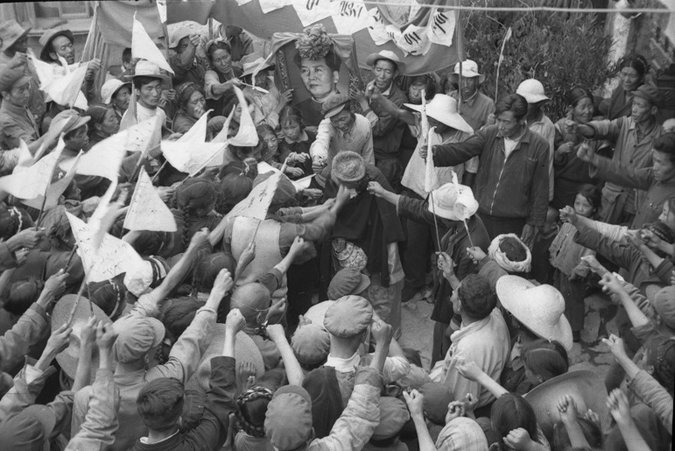
A public rally in Lhasa to force “monsters and demons” to confess their failings. Credit Tsering Dorje
There were two “rebel factions” in Lhasa during the Cultural Revolution. One was the Revolutionary Rebels Headquarters. The other was the Great Alliance of Proletarian Revolutionaries Command, or Great Alliance Command for short. The two fought each other for power. In the later period of the Cultural Revolution, the Headquarters faction lost ground, while the other faction achieved total control, and retained it even after the Cultural Revolution [which ended in 1976]. Headquarters members were purged from the party. Tao Changsong was investigated on suspicion of belonging to the “three types of people” — “people who followed the Lin Biao-Jiang Qing counterrevolutionary faction,” “people with a strong factionalist bent” and “people who engaged in looting and robbery.” After the mid-1980s, he worked at the Tibetan Academy of Social Sciences and served as assistant editor of the journal “Tibet Studies” and as deputy director of the Modern Tibetan Research Institute. Now he’s retired and lives in Chengdu and Lhasa, where he is in good standing with the government.
Mr. Tao is a lively talker with a sharp memory. He also showed his cautious side when he began having difficulty answering my questions about the Red Guards’ campaign against the “Four Olds” at the Jokhang Temple. The statement in his account that left the deepest impression on me concerned the P.L.A.’s crackdown on “second rebels” [Tibetans who revolted in 1969]. He said: “The Tibetans are too simple-minded. If you execute them they say, ‘Thank you.’ If you give them 200 renminbi they also say, ‘Thank you.’ ”
Tibet was an exception to the general practice of purging the “three types of people” after the Cultural Revolution. In Tibet there were few purges of that kind. When Hu Yaobang came to Lhasa in 1980, he put an end to the purging of the “three types.” Why? Because there were many Tibetans among them. Hu thought if you purged them, the party wouldn’t be able to find reliable agents among local Tibetans. So the party couldn’t purge them. And some of them not only were shielded from purges but even received promotions. As a result, the people who rose in power during the Cultural Revolution still dominate Tibet, whether Tibetan or Han.
Tell us about the people in the photographs who were victims of the struggle sessions.
There were about 40 of them. They belonged to a variety of professions in the old Tibet: monks, officials, merchants, physicians, officers, estate overlords and so on. The settings included struggle sessions at mass assemblies, in the streets and at local neighborhood committees that methodically conducted their sessions by turns. The time frame was from August to September 1966. After that, the division between the factions led each to conduct its own separate struggle sessions. The people attacked in these sessions were incorporated into the “monsters and demons” unit, where they were ordered to attend long-term labor and study sessions at their assigned neighborhood committee.
What’s most interesting about these victims is that most were members of the upper class whom the Communist Party from the 1950s to the eve of the Cultural Revolution had designated as “targets to be won over.” And since they did not follow the Dalai Lama and flee the country during the 1959 uprising, the party rewarded them with many privileges. In other words, they were partners of the party. One of them, a monk, even served as an informant for the military.
But after the Cultural Revolution began they were labeled “monsters and demons” and suffered humiliating attacks. In the end they were overtaken by madness, illness and death. Some died during the Cultural Revolution, others afterward. Most of the victims died. Of the few who survived, some went abroad. Some, however, remained in Tibet, where they took up the party’s offer and joined the system to regain their high status. Today these people are found in the Chinese People’s Political Consultative Conference, the National People’s Congress and the Buddhist Association, where they fulfill ceremonial functions needed by the party.

A National Day celebration on Oct. 1, 1966, in Lhasa marking the anniversary of the founding of the People’s Republic of China. Credit Tsering Dorje
Given the fate of most of the victims, the people I interviewed were mostly their relatives, or in some cases the disciples of victimized monks. They told me so many stories.
Such as?
There was the Lhasa nobleman Sampho Tsewang Rinzin, from one of the most renowned noble families in Tibet. Sampho began working with the party in the 1950s and benefited from that. But he was cruelly struggled against during the Cultural Revolution, as you can see in the photos. The Red Guards who were beating him made him wear the uniform of a senior minister in the Tibetan government, which as much as it made him look splendid, brought him so much humiliation and stripped him of all dignity, so that in the end he was sobbing in front of everyone. He died soon after this.
Then there was the “female living Buddha” — an erroneous term; we call them rinpoche — Samding Dorje Phagmo Dechen Chodron. Historically there have been very few female living Buddhas in Tibet. She was the most famous. In 1959 she followed the Dalai Lama and escaped to India. But she was persuaded by party cadres to return to Tibet and was held up as a patriot who had “resolved to shun the darkness and embrace the light.” She even met with Mao. After the Cultural Revolution started she was labeled a “monster and demon” and humiliated at struggle sessions.
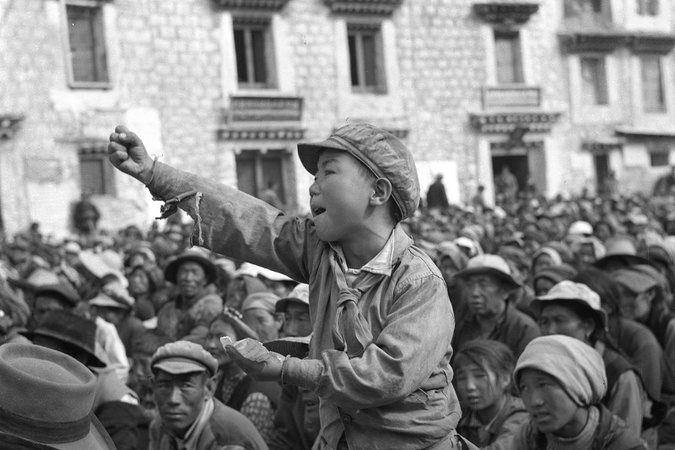
Ngawang Gelek, a member of the Little Red Guards, which replaced the Young Pioneers children’s organization during the Cultural Revolution, at a rally in Lhasa. He later became a militia commander and eventually a devout Buddhist. Credit Tsering Dorje
In the photo where she is shown being beaten, she was only 24. She was weak then, because she had recently given birth to her third child. Her husband was the son of the great Lhasa nobleman Kashopa. The couple eventually divorced. It was her ex-husband who told me about her experiences as well as those of her parents after I showed him the photos.
Today, Dorje Phagmo is vice chairwoman of the Tibetan Autonomous Region and a member of the Chinese People’s Political Consultative Conference Standing Committee. She often appears on television attending various conferences.
Did you interview the Red Guards in the photos?
In one of my father’s photos there is a female activist, a quite vicious one during the Cultural Revolution. She once led a team to ransack a house where she not only seized the owner’s property but set fire to manuscripts bequeathed to the owner by the great Tibetan scholar Gendun Choephel. A Tibetan scholar called this a major crime against Tibetan history and culture. Later this woman became party secretary at the Wabaling neighborhood committee. When I found her there, she looked quite insignificant. As soon as I brought up the Cultural Revolution, her facial expression immediately changed. She refused to give an interview or let me take her photo.
There was also a former monk I interviewed who had smashed Buddhist stupas and burned scriptures during the Cultural Revolution. Afterward, he volunteered to be a janitor at the Jokhang Temple and worked there for 17 years. He told me: “If it weren’t for the Cultural Revolution, I think I would have lived my entire life as a good monk. I would have worn monk’s robes. The temples would still be there. Inside the temples I would have devotedly read scriptures. But the Cultural Revolution came. The robes could no longer be worn. Though I have never looked for a woman or abandoned monastic life, I am not fit to wear the robes again. This is the most painful thing in my life.”




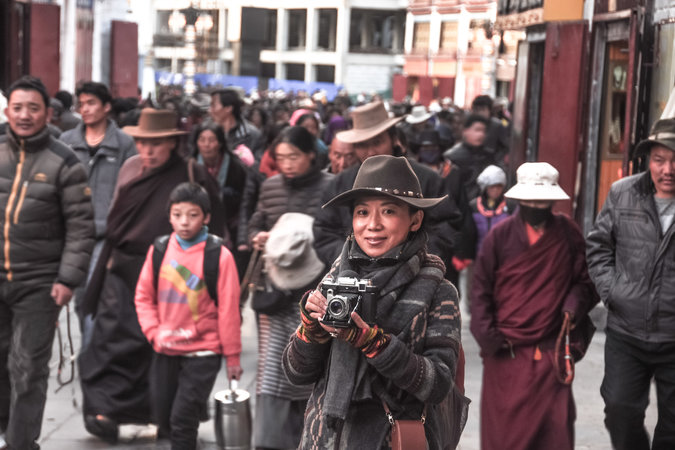

 Print
Print Email
Email